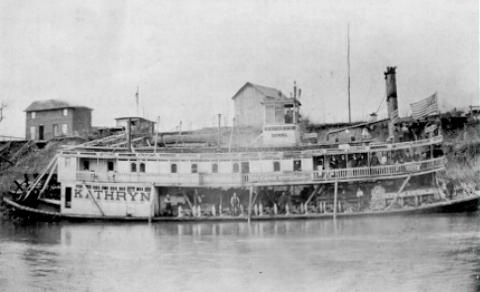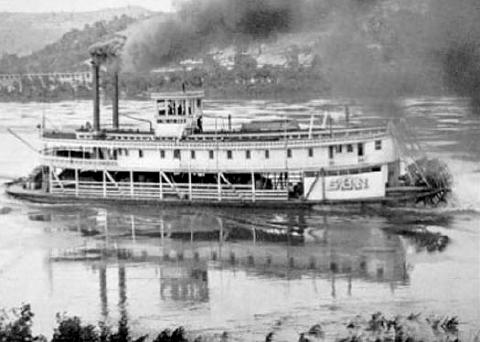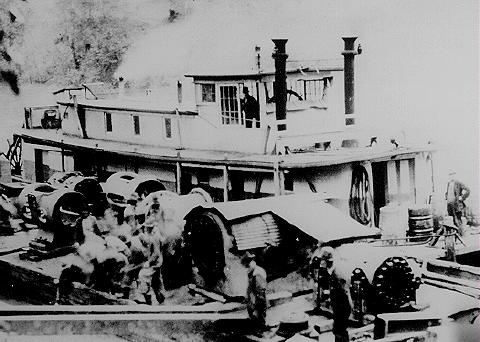
Riverboat "Kathryn" Previously named "W.A. Hilton", loaded flat with Deering harvesting machinery on her way to Grantsville, W. Va. This view is said to have been taken opposite Creston, obviously posed. There are signs attached in the roof rail about every twelve feet saying DEERING. One on the boiler deck rail, forward, says DEERING LEADS. These DEERING signs are wrapped around the smokestacks. Evidently this was quite an exploit although we have not run across printed accounts. Apparently this was in March or early April in the 1897-1900 period.
(From S&D Reflector, March 1950)
Transportation In Calhoun County (First 100 Years)
A. G. Mathews, Member of Historical Committee
Calhoun Centennial 1956
The early settlers in this valley moved and transported themselves and their goods, wares and merchandise by foot, horseback and by vehicles drawn by horses or oxen.
Later the merchants at Grantsville hauled their goods by wagon from Cairo on the B & 0 Railroad or from Burning Springs, then the head of slack water navigation.
It took two to three days to make the trip to either of these places and return and the rate paid by them was $1.00 per hundred pounds.
There is a legend that when the first wagon was brought to this area the boys of the neighborhood followed it for miles to see if the hind wheels would over take the front wheels.

Riverboat "Sun"
The packet boat "Sun" was nominated as the best packet on the Little Kanawha. Note the fanciful sunrise painted behind the name on the engine room bulkhead. Author's thanks to Bert Fenn for picture. It was not taken on the Little Kanawha, rather, down the Ohio somewhere around Portland, O. This boat was owned later by the Lee Line at Memphis.
(Photo from the S&D Reflector, 1950)
Before the coming of the steamboat, the automobile and good roads, our forefathers moved themselves and their belongings from place to place on the river in canoes or on log rafts.
Students from Wood. Wirt and Calhoun Counties attending the Glenville Normal School, now Glenville State College, at Glenville, seeking to find a way home at the end of the term, would frequently fasten two logs together and float happily down stream to their respective homes.
The river was also a cheap medium for the transportation of timber to market. At high tide its channels were filled with log and tie rafts and logs and railroad cross ties floating loose and drifting down stream with the current, on their way to be manufactured into lumber and furniture at Parkersburg and at places down the Ohio River as far as Cincinnati.

Steamboat "Chase"
Unloading Engines for Compressor Station at Cabot Station About 1904
(Photo courtesy of Robert J., Jr. and Hazel Collins Knotts)
The large quantities of oil produced in the Burning Springs fields in the 1860s was shipped in barrels loaded on barges towed by steamboats to the Camden Refinery at Parkersburg.
Among the more important steamboats hauling passengers and freight from the head of navigation to Parkersburg were the C. C. Martin, Oneida and W. A. Hilton.
In order to facilitate the transportation of oil, to the refinery by river, a private corporation was organized which constructed four locks and dams providing slack water navigation as far up the river as Burning Springs. Later the Federal Government purchased these locks and dams and constructed Lock No. 5 which made navigation the year around possible as far as Creston.
When there was a large rise in the river, steamboats would make a trip once or twice a year as far up the river as Glenville. When the word would reach Grantsville that a steamboat was on its way to Glenville everybody you met would greet you with the question, "Are you goin' on a boat to Glenville?"
On these trips, the steamboats would deliver heavy freight such as salt, nails, horseshoes, wire, and other commodities to the merchants along the river.
The importation of such heavy commodities as herein before stated gave rise to serious economic and transportation problems. The expense of hauling these wares by wagon was too great to be borne.
It has been said that where there is a will there is a way; and there upon came Uncle Billy Gates and Captain Norm Williams who introduced the bateau or push boat on the river when it was thought that the transportation problem had been solved.
Some times it would take a week or more to make a round trip from Grantsville to Creston or to Burning Springs, depending upon the stage of the water. The going down stream was easy but coming back was tough. The force of the current had to be met and overcome by man power.
It was not long, however, until the ingenuity of the old time boatman made progress possible and the gasoline boat took the place of the old push boat or bateau and the force of the current was conquered by the power of the gasoline engine assisted at times by human hands using push poles to get the boat over the riffles.
Every boatman now living has a vivid recollection of the force and labor it took to get his boat over what was known as the "Stocking-Heel Riffle", near Brooksville.
At certain stages of the river as the boat approached the riffles all hands were called out, armed with push poles and by the captain commanded to push. Boating on the Little Kanawha seemed to be a hard life but the boys who manned the boats went willingly to their tasks, joked with the passengers and sang as they went on their merry way.
Boating on the upper reaches of the. Little Kanawha at one time was a very lucrative business. Gasoline boats hauled carbon black manufactured by Godfrey L, Cabot at his plant near Grantsville, on the way down to market, and on their way back carried goods, wares and merchandise to be delivered to merchants and consumers all along the valley.
During the early days and the high tide of the oil development in Calhoun and Gilmer counties, vast amounts of casing, machinery and heavy oil field equipment was delivered all the way along the river between Creston and Glenville.
The reduced freight rate made possible by these boats over the cost of transportation by the old horse and wagon method saved to the consumers in the valley many thousands of dollars.
The names of some of the men most prominent in the operation of gasoline boats on the river who will long be remembered for their services are Captain Norm Williams, Captain H. 0. Stevens, the Huffman brothers, James, Jake and Oak, the Stump brothers, Roy, Oak, Wade and Bill, Charley Starcher, Jacob Stump, Ira Hardman, J. G. Oles and his sons, Norman, Lynn and Sam, the Turner brothers, Bruce Ferrell, Sr., and Joseph M. Smith; and the names of some of the boats were Wabash, Edith H., Return, Reliance, Clarence S., Grantsville, Henrietta, Lark, Eagle, Harry W., Paul S., Harold H., Virginia R., Acme, J. G. Oles, Martha H., and Godfrey L. Cabot.
There are many other names that the writer of this article can not now recall. These boats carried both freight and passengers and the owners and operators were always kind, courteous and helpful in both the handling of freight and the transportation of passengers.
One of the pioneer gasoline boats on they river was named the Lula F. and was built and operated by Wirt Ball of Burning Springs. This boat was built as an experiment and turned out disastrously to its owner and builder who was caught in some part of its machinery and killed.
Time in its ceaseless march has brought many changes. The advent of the automobile, the power driven truck and the improved road system have increased the speed of the delivery of freight, hauling of passengers, and a lowered freight rate so as to make impossible the former systems of transportation on the Little Kanawha River to exist.
We still have the river that, like Tennyson's brook, "goes on forever". All water craft carrying freight and passengers for hire have vanished and gone.
The whistle and snap of the gasoline engine is heard no more. Many of the captains and crews of these vessels have passed to the great beyond and there is now left only a memory of their activities and the services they rendered to the business and the people of the Little Kanawha Valley. We are living in an age of speedy and rapid transportation driven by mechanical, forces with ease and free from human labor. Let us not, however, forget the era of the bateau and the gasoline boat and remember the sacrifices, the sweat, and labor of those who performed the services of that day.
William M. Hall, Assistant U. S. Engineer, who was directed by the War Department of the U. S. Government to examine the Little Kanawha River with the view of continuing its improvement by locks and dams as far as Burnsville, in his report says:
"In the upper part of the valley there are two great veins of coal outcropping on the hillsides on each side of the river, i.e. the Pittsburgh Vein, with a thickness of 5 to 7 feet, which extends from Glenville to within two or three miles of Burnsville, a distance of about 18 miles and the Freeport Vein which out crops near Bulltown, at which point it is about 7 feet thick".
He further states, in his report, a survey made by S. D. Brady, mining engineer, employed by the state of West Virginia, shows that there are 60,000 acres of merchantable Pittsburgh Coal and 40,000 acres of the Freeport Vein above water which may be mined by drifting; and that in addition there are several thousand acres of the Pittsburgh Vein below water which can be mined by shafts and many thousand acres of the Freeport Vein below water which can be mined by shafting.
He further states:
"Should we for argument sake suppose that on 20,000 acres of each of these coals, the Pittsburgh and Freeport, be moved by water, and that it would go out at the rate of 8,000 tons per day (equal to 250 car loads, or sixteen 500 ton barge loads) at that rate it would take nearly 100 years to move it".
With this vast storehouse of riches hidden in the hills at the head waters of the river is it too much to hope that the Little Kanawha will again become an active artery of commerce and that coal will be transported to Parkersburg which may become a distributing point to supply the industries in the Ohio Valley and in different parts of the nation?
| 


